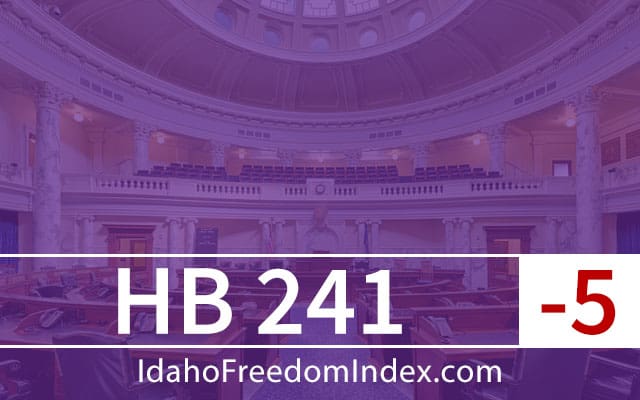


Bill description: HB 241 would establish a new type of taxing district, for county fairs.
Rating: -5
Does it create, expand, or enlarge any agency, board, program, function, or activity of government? Conversely, does it eliminate or curtail the size or scope of government?
House Bill 241 would expand government power by allowing for the creation of a new type of taxing district. Many counties across Idaho already own fairgrounds or provide county fair services as one of their functions. This bill, if passed, l would create a new type of taxing district (county fair taxing districts) with the sole purpose of providing fair services to residents within its boundaries, and it would levy taxes for that purpose.
The creation of this type of district would begin with a petitioner filing a petition with the county clerk that has “the boundaries of the proposed district, shall state the name of the proposed district, shall state the maximum tax rate that would be imposed upon taxable property within the district, and shall be signed by no less than twenty percent (20%) of the qualified electors residing within the boundaries.” Based on the language of this bill, the actual petitioner would not have to be a resident of the would-be district. After the county clerk receives the petition, the county commissioners would review it and call for an election. If the taxing district is approved by ⅔ of voters, then it would begin levying taxes.
The new taxing district would be governed by three residents on the board of directors. These directors would, at first, be appointed by commissioners. After that, they would be voted on by political subdistricts, with one member coming from each of three established subdistricts. This entire process would enlarge the size of government.
(-1)
Does it transfer a function of the private sector to the government? Examples include government ownership or control of any providers of goods or services such as the Land Board's purchase of a self-storage facility, mandatory emissions testing, or pre-kindergarten. Conversely, does it eliminate a function of government or return a function of government to the private sector?
The creation of a taxing district specifically for fairs transfers entertainment services from the private sector to the public sector. Traditionally, entertainment services have been provided by organizations in the private sector, such as private movie theatres, private restaurants, night clubs, performance centers and others. Government entities in Idaho are increasingly providing certain entertainment services, like ice rinks and golf courses. With this transfer of these services from the private to the public sector, the burden of paying for the service falls on all residents, regardless of whether they use the service. In the case of a fair district, all residents within the district would pay toward its expenses, whether they want to attend the fair or not.
(-1)
Does it directly or indirectly create or increase any taxes, fees, or other assessments? Conversely, does it eliminate or reduce any taxes, fees, or other assessments?
House Bill 241 would create a new taxing district that would levy taxes from residents within its boundaries. The tax rate after the district is created would be determined by the board of directors, but it could not exceed the tax rate set by the original petitioner for the creation of the district.
A reason for the creation of this taxing district, as listed in the Statement of Purpose for this bill, “is to provide the opportunity for the entire populous to attend the Fair at no cost for entrance regardless of their financial position.” But the bill never mentions that admission for a county fair has to be free. The district could levy taxes to run the fair and still charge an entrance fee.
(-1)
Does it increase government spending (for objectionable purposes) or debt? Conversely, does it decrease government spending or debt?
Once it is created, a county fair taxing district would have the authority to issue bonds—some with voter approval and some without. Issuing bonds would put these taxing districts in debt, adding to the overall government debt in Idaho.
(-1)
In addition, in most instances, the county would be obligated to refund the petitioner for certain costs. The person who submits a petition for a new taxing district must submit an up-front payment, on an out-of-pocket basis, to cover the county’s expense in holding an election. If the petition never makes it on a ballot because it is denied by county commissioners, then the petitioner’s payment is refunded. If, on the other hand, the petition makes it to the ballot and then is approved by voters, the petitioner gets paid back from the taxes first collected from the new district. There is no provision for the county to reimburse the petitioner if voters reject the creation of the new district.
(-1)

